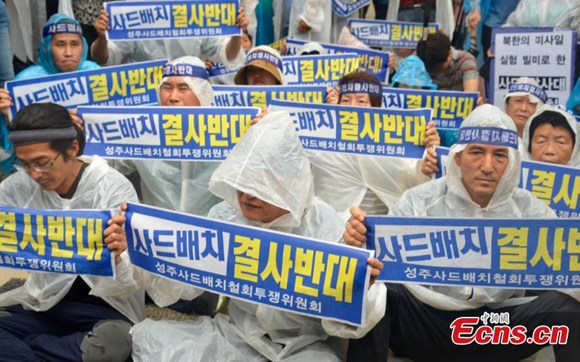
People gather near the presidential Blue House to protest against the further deployment of THAAD in Seoul, South Korea, July 31, 2017 (Photo: China News Service/Wu Xu)
A protest rally against the U.S. Terminal High Altitude Area Defense (THAAD) missile defense system continued here on Tuesday after President Moon Jae-in ordered a consultation with the United States on further deployment of THAAD launchers.
Amid the sweltering heat, environmental activists gathered at the Gwanghwamun square in central Seoul, demanding an immediate withdrawal of the U.S. missile shield which has been deployed to the country's southeastern region.
It followed the Monday demonstration outside the presidential Blue House and the defense ministry's headquarters, in which over 100 peace activists and residents living near the THAAD site participated.
The green activists read a statement endorsed by about 40 environmental groups, calling on the government to conduct a "strategic" environmental impact assessment, not a "general" green audit.
The Moon government, which was inaugurated on May 10, announced a plan in late July to carry out the assessment of the THAAD's environmental impact on the deployment site, while part of the U.S. missile shield is operational and construction is underway.
The strategic assessment requires the withdrawal of the already deployed THAAD elements as it has to go through procedures, such as the assessment on whether the THAAD deployment is necessary, before the installation of any THAAD element.
The green activists said in the statement that the THAAD's environmental damages to people, including electromagnetic waves and noise, have not been evaluated yet, demanding a thorough verification of potential harm.
The AN/TPY-2 radar is known to emit super microwave that is detrimental to human body and environment. One THAAD battery is composed of six mobile launchers, 48 interceptors, the radar and the fire and control unit.
The statement also expressed opposition to the decision to deploy four more THAAD launchers to the former golf course in Seongju county, North Gyeongsang province, where two launchers and other elements have been installed since April 26.
President Moon ordered the consultation with the U.S. side on additional installation following the Democratic People's Republic of Korea (DPRK)'s test-launch of a ballistic missile of intercontinental range late Friday night.
"Additional THAAD deployment cannot become a way to resolve North Korea (DPRK)'s nuclear and missile threats as THAAD is incapable of intercepting any intercontinental ballistic missile (ICBM)," said the statement.
The DPRK's ICBM is not a direct threat to the South Korean territory as an ICBM strike target covers at least 5,500 km.
THAAD is unable to shoot down DPRK missiles targeting the South Korean territory as the U.S. missile defense system is designed to intercept missiles at an altitude of 40-150 km. The DPRK attack missiles, which take aim at South Korea, fly at an altitude of less than 40 km.
The THAAD in Seongju cannot protect the most-populated Seoul and its suburban metropolitan areas, which house about half of the country's 50 million population, as the capital city is located only 300 km away from the demilitarized zone.


















































